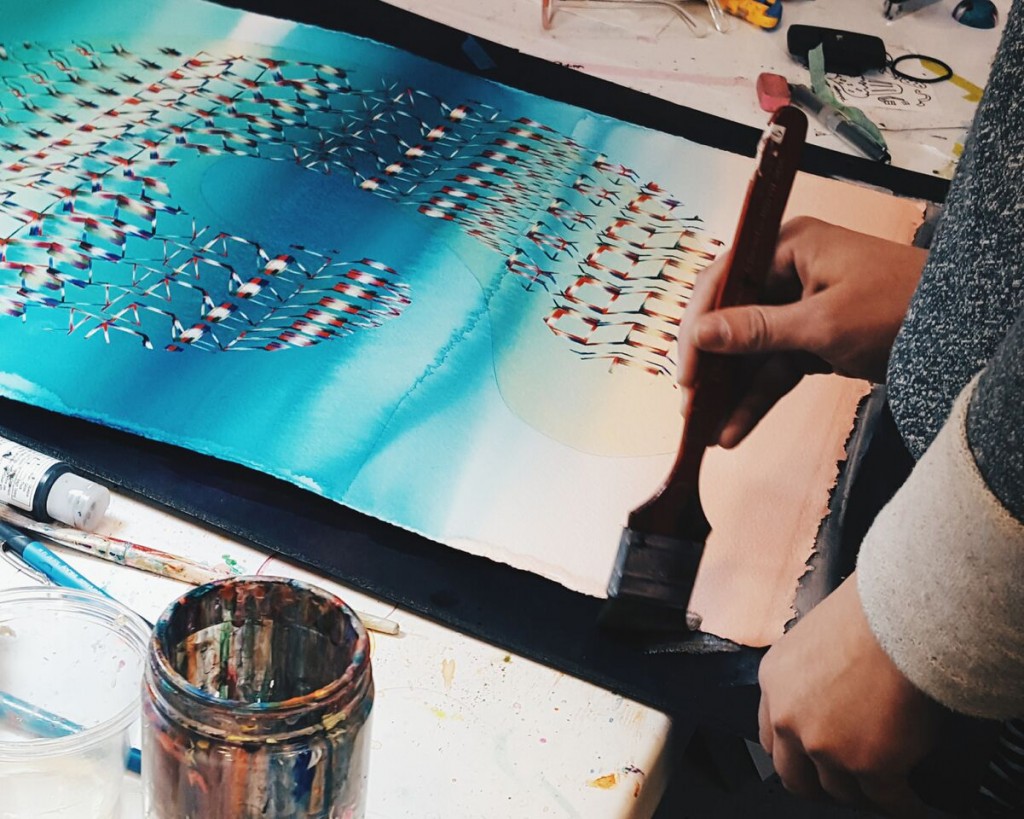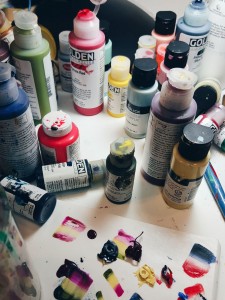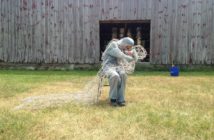In Here to Create, BR&S contributor Courtney Moy speaks to female artists on how they’ve created their own course within the Boston art scene. In this installment, she talks to Vanessa Irzyk, a MassArt graduate who currently has a studio in South Boston’s Distillery building. Irzyk works as an educator and shares with BR&S how she sustains her work. Irzyk’s solo show, FLAT ZEN, is currently on view at the Mingo Gallery in Beverly.
Tell us about yourself and the path that lead you to where you are today. What made you decide to make Boston your home base?
I am a Boston area artist and teacher exploring color and angles. I went to MassArt for painting and art education and began teaching at local art centers while still an undergrad. During my senior year, I was taking night classes to finish my second degree in art education. I was teaching weekdays full-time at a middle school in Dorchester, Saturdays at the Brookline Art Center, and painting pottery for a company until 2AM. I would sleep in their kitchen, wake up, write a paper, and go back to Dorchester. After my last review of senior year, my two friends and I signed a lease on a studio space that I’ve been at ever since. I never left those teaching jobs. Right after college I got an apartment, a studio, and managed to float between two to three teaching gigs.
I worked really hard and made a lot of connections along the way. I was teaching one day a week at the Brookline Arts Center, then it was nine classes a week. I eventually became their full-time Studio Manager. I left the Arts Center just as new management came in and began teaching at the Newton Montessori School where I’m at now. Having a FT job and a studio was hard at the beginning. Sometimes I just went there and did nothing from exhaustion. Slowly things became more manageable. I got a car and have been able to create more.
More than anything I think my teaching jobs and my studio has kept me here, along with family and friends. Honestly, if I tried to move it wouldn’t be guaranteed that I’d have a teaching job and a studio. I’ve made so many connections at the Arts Center and at the Distillery studio over the years. Staying in Boston worked for me.

Vanessa Irzyk in her Distillery studio. Photo by Courtney Moy.
Was it difficult defining your career after graduating MassArt? Have you had any mentors along the way, or did you go it alone?
In school I didn’t really listen to anyone. I just did work that I was interested in, kept making as much work as I could, and applied to as many shows as possible. My friends influenced me the most. We’re all still very close. We help each other in our careers, provide feedback, references, and suggestions of things to apply to, and support each other at openings and presentations.
Did you have an “aha” moment when you realized teaching was a passion or career path?
I started teaching when I was seventeen at a local art center. I realized very quickly in college that teaching was going to be my financial stability. My first painting professor started the class off saying, “If you think you’re going to live off of painting, you’re kidding yourself. It’s not going to happen.” The next day I double majored in painting and art education.
What’s it like to work with second graders? Are they brutally honest?
Yes, the younger the more honest. They will call you out on EVERYTHING. Try wearing new eyeliner or a headband and you won’t hear the end of it. My favorite age to teach is 4-7. Younger kids just love to explore and see what happens. It’s a magical age.
I use a lot of energy creating project ideas for my students. I work at a Montessori school and we’re on a three-year cycle. So I can’t repeat any projects for three years. Which makes things challenging, but fun. I love coming up with a range of projects. Lately I’ve had the kids do monochromatic still-lives, color gradations, and printmaking with foam plates. It’s interesting to see the way students put things together. Some kids will do things the same as one another. Others will go buck wild! You see a lot of a student's personality by the way they paint or draw. We just finished an Andy Warhol inspired project where the kids designed six plus different colored juice boxes. I was so proud I Instagramed it. It’s the best job.
Color has always been a theme of exploration for you, can you describe the genesis of your new body of work FLAT ZEN with the patterns and symmetry mark making. How has your style evolved as you’ve matured?
The FLAT ZEN series emerged in between projects. I was always drawing patterns for fun but struggled with defining it as painting or just pattern making. I started painting complex designs and cutting them out for a year or two but they became so fragile and complex to present. So I began working on heavy duty watercolor paper that can stand on its own.
My mark making is very intuitive. Nothing is pre-planned or sketched beforehand. I start with washes of thin acrylic paint. For some pieces the washes serve as the atmosphere for the developing structures, while in other works they inform how the structures will develop. All the structures in FLAT ZEN were painted with small flat brushes. I have had people come up at openings and say the images I create are reminiscent of North American designs and patterns. I take inspiration from everywhere, but my process is very stream of consciousness. Each piece is meant to transport the viewer to a hypnotic place.

What is your process of working in the studio usually like?
I go to the studio either after work or for long periods of time on the weekends. I usually have a couple of different pieces going at the same time. I need noise, so I usually have on NPR or Law and Order (the two best art aides). When I’m working on a series I keep trying to push parts of the main ideas and when I’m in between projects I try to just paint on everything until some mistake turns into something new.
You also live an active and healthy lifestyle. How do you balance a 9-5, studio time, and healthy living?
Fear. I think I have a healthy fear of being lazy and not making art. In school I had a bit of a complex with my double major because I didn’t want to be known as just a hooky art teacher. I wanted to be a painter. For me the balance is to do a bit of everything. I like to workout everyday doing different things. I spent my whole life doing ballet, so occasionally I’ll take classes. They have a live pianist, which is so amazing. I do a boot camp outside year round that I really love. It’s super early in the morning, but I found a great community of people who have become another kind of support system for me.
Not everything is going to be up all the time. Sometimes one thing – be it art, teaching, or relationships -- is always off. I think you just have to keep making yourself continue on, even if a painting isn’t working or whatever it may be.

Vanessa Irzyk's studio. Photo by Courtney Moy.
What other projects are you working on?
I’ve been paying more attention to geometric and organic shapes in nature. Sketching from puddles, mold, or moss. Instead of painting organized lines and linear shapes like in FLAT ZEN, I’m trying to be more loose and organic with it.
What is the best advice you’ve received in the last year?
Keep making work. I’ve had so many friends stop making work after college. It gets really hard to continue with jobs, relationships, time, and money involved. But you have to set time aside for it and make art a priority. And keep applying to things! I’ve given so much money to show applications and residencies and been rejected that I feel like a real patron of the arts.
As told to Courtney Moy on February 26, 2016




